Laboratory and In Situ Stabilization of Compacted Clay through Granite Waste Powder
Abstract
:1. Introduction
2. Materials and Methods
2.1. Granite Waste Samples
2.2. Clay Soil
2.3. Samples Preparation for Laboratory Testing
- Results from proctor compaction and specific gravity tests were employed in three phase-derived relationships (Table 1).
- To determine the void ratios, the following equation was used.
- 3.
- To determine Vv the derived relation is
- 4.
- To determine the solid volume (Vs), the equation is given as
- 5.
- To determine the porosity, the following equation was used.
- 6.
- To determine the degree of saturation, the following derived weight–volume relationship was utilized
2.4. In Situ Soil Sampling and Laboratory Testing
3. Results
3.1. Characterization
3.2. Particle Size and Mineralogical Composition
3.3. Geotechnical and Mineralogical Parameters of the Granite-Cutting Waste
3.4. Compaction Parameters
3.5. Shear Strength Parameters
3.6. SG, UCS, and CBR
3.7. Porosity, Void Ratio, and Saturation Potential
3.8. Foundation Analysis
4. Discussion
5. Conclusions
- Adding up to 40% granite-cutting waste significantly improves the quality of compacted clay in both the field and laboratory setting by (a) enhancing bearing capacity, CBR, UCS, SG, DD, angle of internal friction, and penetration resistance and (b) greatly reducing porosity, void ratio, saturation potential, OMC, and PI. Hence, granite-cutting waste powder is recommended for use as an admixture in the geotechnical industry to stabilize clay so that harmful environmental concerns could be avoided.
- The impact on clay properties from the granite-cutting waste powder is higher in laboratory stabilization than in stabilization in the field, obviously because of differences in testing environment, soil volume, compaction energy, and efforts.
Author Contributions
Funding
Data Availability Statement
Conflicts of Interest
References
- Steinberg, M. Expansive soils and the geomembrane remedy. In Advances in Unsaturated Geotechnics; American Society of Civil Engineers: Reston, VA, USA, 2000; pp. 456–466. [Google Scholar] [CrossRef]
- Arora, D.K.R. Soil Mechanics and Foundation Engineering, 6th ed.; 170S-B; Nai Sarak: Delhi, India, 2003; p. 903. [Google Scholar]
- Zumrawi, M.; Abdalla, E.A.E. Stabilization of Expansive Soil using Marble Waste Powder. In Second Conference of Civil Engineering in Sudan; University of Khartoum: Khartoum, Sudan, 2018. [Google Scholar]
- Bakhshizadeh, A.; Khayat, N.; Horpibulsuk, S. Surface stabilization of clay using sodium alginate. Case Stud. Constr. Mater. 2022, 16, e01006. [Google Scholar]
- Bahrami, R.; Khayat, N.; Nazarpour, A. Effect of nano-stabilizer on geotechnical properties of leached gypsiferous soil. Geomech. Eng. 2020, 103–113. [Google Scholar] [CrossRef]
- Shah, S.H.A.; Arif, M.; Asif, M.E.; Safdar, M. Influence of granite cutting waste addition on the geotechnical parameters of cohesive soil. Int. J. Eng. Res. Adv. Technol. 2019, 5, 64–74. [Google Scholar] [CrossRef]
- Shah, S.H.A.; Arif, M.; Rehman, Q.; Manzoor, F. Utilization of dolerite waste powder for improving geotechnical parameters of compacted clay soil. Open Geosci. 2021, 13, 1523–1535. [Google Scholar] [CrossRef]
- Shah, S.H.A.; Arif, M.; Sabir, M.A.; Tanoli, J.I.; Asma, S.; Lodhi, H.T. The effect of weathering on the appropriateness of granite for clay stabilization. Acta Geotech. Slov. 2022, 48–56. [Google Scholar]
- Hoy, M.; Rachan, R.; Horpibulsuk, S.; Arulrajah, A.; Mirzababaei, M. Effect of wetting-drying cycles on compressive strength and microstructure of recycled asphalt pavement-fly ash geopolymer. Constr. Build. Mater. 2017, 144, 624–634. [Google Scholar] [CrossRef]
- Latifi, N.; Horpibulsuk, S.; Meehan, C.L.; Abd Majid, M.Z.; Tahir, M.M.; Mohamad, E.T. Improvement of problematic soils with biopolymer—An environmentally friendly soil stabilizer. J. Mater. Civ. Eng. 2016, 29, 04016204–04016211. [Google Scholar] [CrossRef]
- Latifi, N.; Rashis, A.; Siddiqua, S.; Abd Majid, A. Strength measurement and textural characteristics of tropical residual soil stabilization with liquid polymer. Measurement 2016, 91, 46–54. [Google Scholar] [CrossRef]
- Phummiphan, I.; Horpibulsuk, S.; Rachan, R.; Arulrajah, A.; Shen, S.L.; Chindaprasirt, C. High calcium fly ash geopolymer stabilized lateritic soil and granulated blast furnace slag blends as a pavement base material. J. Hazard. Mater. 2018, 341, 257–267. [Google Scholar] [CrossRef]
- Zorluer, I.; Gucek, S. The effects of marble dust and fly ash on clay soil. Sci. Eng. Compos. Mater. 2014, 21, 59–67. [Google Scholar] [CrossRef]
- Yang, W.; Gao, H.; Yang, Y. Analysis of Influencing Factors of Embodied Carbon in China’s Export Trade in the Background of “Carbon Peak” and “Carbon Neutrality”. Sustainability 2022, 14, 3308. [Google Scholar] [CrossRef]
- Yang, W.; Gao, H.; Yang, Y.; Liao, J. Embodied Carbon in China’s Export Trade: A Multi Region Input-Output Analysis. Int. J. Environ. Res. Public Health 2022, 19, 3894. [Google Scholar] [CrossRef]
- Shirazi, E.K. Reusing of stone waste in various industrial activities. In 2nd International Conference on Environmental Science and Development IPCBEE; IACSIT Press: Singapore, 2011; Volume 4. [Google Scholar]
- Montero, M.A.; Jordan, M.M.; Almendro, C.; Sanfeliu, T.; Hernandez-Crespo, M.S. The use of a calcium carbonate residue from the stone industry in manufacturing of ceramic tile bodies. Appl. Clay Sci. 2009, 43, 186–189. [Google Scholar] [CrossRef]
- Shams, F.A. A preliminary account of the geology of the Mansehra area, District Hazara, West Pakistan. Geol. Bull. Univ. Punjab 1961, 1, 57–67. [Google Scholar]
- Ashraf, M. Geology and petrology of acid minor bodied from Mansehra and Batgram area, Hazara district, Pakistan. Geol. Bull. Univ. Punjab 1974, 11, 81–88. [Google Scholar]
- Naeem, M.; Khalid, P.; Anwar, A.W. Construction material prospects of granitic and associated rocks of Mansehra area, NW Himalaya, Pakistan. Acta Geod. Geophys. 2015, 50, 307–319. [Google Scholar] [CrossRef] [Green Version]
- ASTM D6473; Standard Test Method for Specific Gravity and Absorption of Rock for Erosion Control. ASTM International: West Conshohocken, PA, USA, 2015.
- ASTM D7012-14; Standard Test Methods for Compressive Strength and Elastic Moduli of Intact Rock Core Specimens under Varying States of Stress and Temperatures. ASTM International: West Conshohocken, PA, USA, 2014.
- ASTM C136/C136M; Standard Test Method for Sieve Analysis of Fine and Coarse Aggregates. ASTM International: West Conshohocken, PA, USA, 2019.
- ASTM D7928; Standard Test Method for Particle Size Distribution (Gradation) of Fine-Grained Soils Using the Sedimentation (Hydrometer) Analysis. ASTM International: West Conshohocken, PA, USA, 2017.
- ASTM D4318; Standard test methods for liquid limit, plastic limit and plasticity index of soils. ASTM International: West Conshohocken, PA, USA, 2000.
- ASTM D698; Standard test method for laboratory compaction characteristics of soil using standard effort. ASTM International: West Conshohocken, PA, USA, 2000.
- ASTM D3080/D3080M; Standard Test Method for Direct Shear Test of Soils under Consolidated Drained Conditions. ASTM International: West Conshohocken, PA, USA, 2011.
- ASTM D854; Standard test methods for specific gravity of soil solids by water pycnometer. ASTM International: West Conshohocken, PA, USA, 2014.
- ASTM D1883; Standard test method for CBR (California bearing ratio) of laboratory compacted soils. ASTM International: West Conshohocken, PA, USA, 1999.
- ASTM D2166-06; Standard test method for unconfined compressive strength of cohesive soil. ASTM International: West Conshohocken, PA, USA, 2006.
- Terzaghi, K. Theoretical Soil Mechanics; Wiley: New York, NY, USA, 1925. [Google Scholar]
- Budhi, M. Soil Mechanics and Foundations, 3rd ed.; Wiley & Sons, Inc.: New York, NY, USA, 2010. [Google Scholar]
- ASTM D1556; Standard Test Method for Density and Unit Weight of Soil in Place by the Sand-Cone Method. ASTM International: West Conshohocken, PA, USA, 2007.
- Bowles, J.E. Foundations Analysis and Design, 3rd ed; McGraw-Hill: New York, NY, USA, 1982. [Google Scholar]
- Al-Swaidani, A.; Hammoud, I.; Meziab, A. Effect of adding natural pozzolana on geotechnical properties of lime-stabilized clayey soil. J. Rock Mech. Geotech. Eng 2016, 8, 714–725. [Google Scholar] [CrossRef] [Green Version]
- Shah, S.H.A.; Arif, M.; Sabir, M.A.; Iqbal, J. In-situ stabilization of clays with lime, dolerite and quartzite powders. Acta Geodyn. Geomater. 2020, 3, 341–352. [Google Scholar] [CrossRef]
- Shah, S.H.A.; Arif, M.; Sabir, M.A.; Rehman, Q. Impact of igneous rock admixtures on geotechnical properties of lime stabilized clay. Civ. Environ. Eng. 2020, 16, 329–339. [Google Scholar] [CrossRef]
- Iqbal, J.; Dai, F.; Hong, M.; Tu, X. Failure mechanism and stability analysis of an active landslide in the Xiangjiaba reservoir area, South-west China. J. Earth Sci 2018, 29, 646–661. [Google Scholar] [CrossRef]
- Xu, L.; Dai, F.C.; Chen, J.; Iqbal, J.; Qu, Y. Analysis of a progressive slope failure in the Xiangjiaba reservoir area, Southwest China. Landslides 2014, 11, 55–66. [Google Scholar] [CrossRef]
- Moos, A.V. Geotechnical Properties and Investigation Methods of Loose Rocks; Earthwork Course of E.T.H., No. 4 (Zurich); Faculty of Science, University of London: London, UK, 1938. [Google Scholar]
- Ogbonnaya, I.; Illoabachie, D.E. The potential effect of granite dust on the geotechnical properties of Abakalili clays. Cont. J. Earth Sci. 2011, 6, 23–30. [Google Scholar]
- Sivrikaya, O.; Kıyıldı, R.K.; Karaca, Z. Recycling waste from natural stone processing plants to stabilise clayey soil. Env. Earth Sci. 2014, 71, 4397–4407. [Google Scholar] [CrossRef]
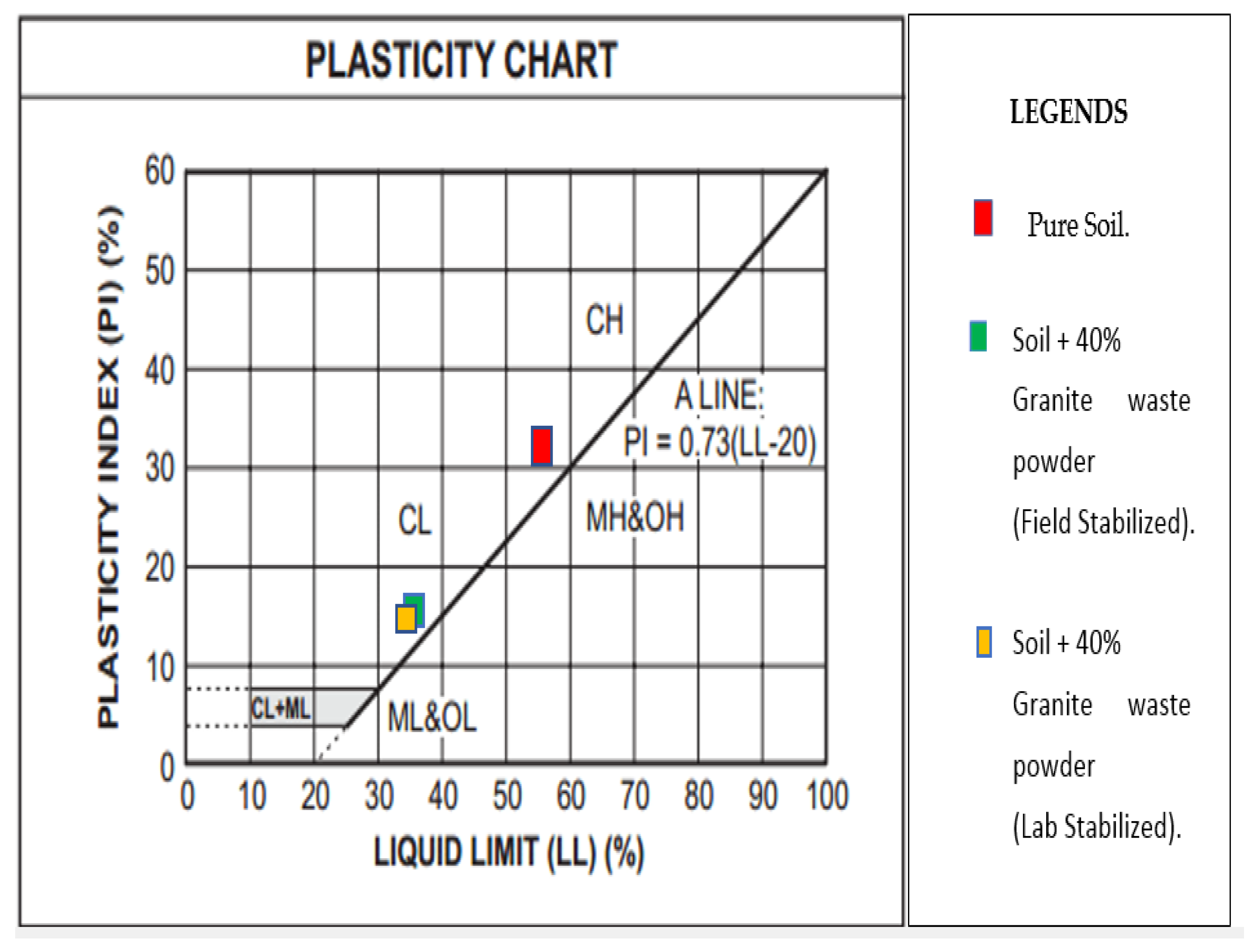


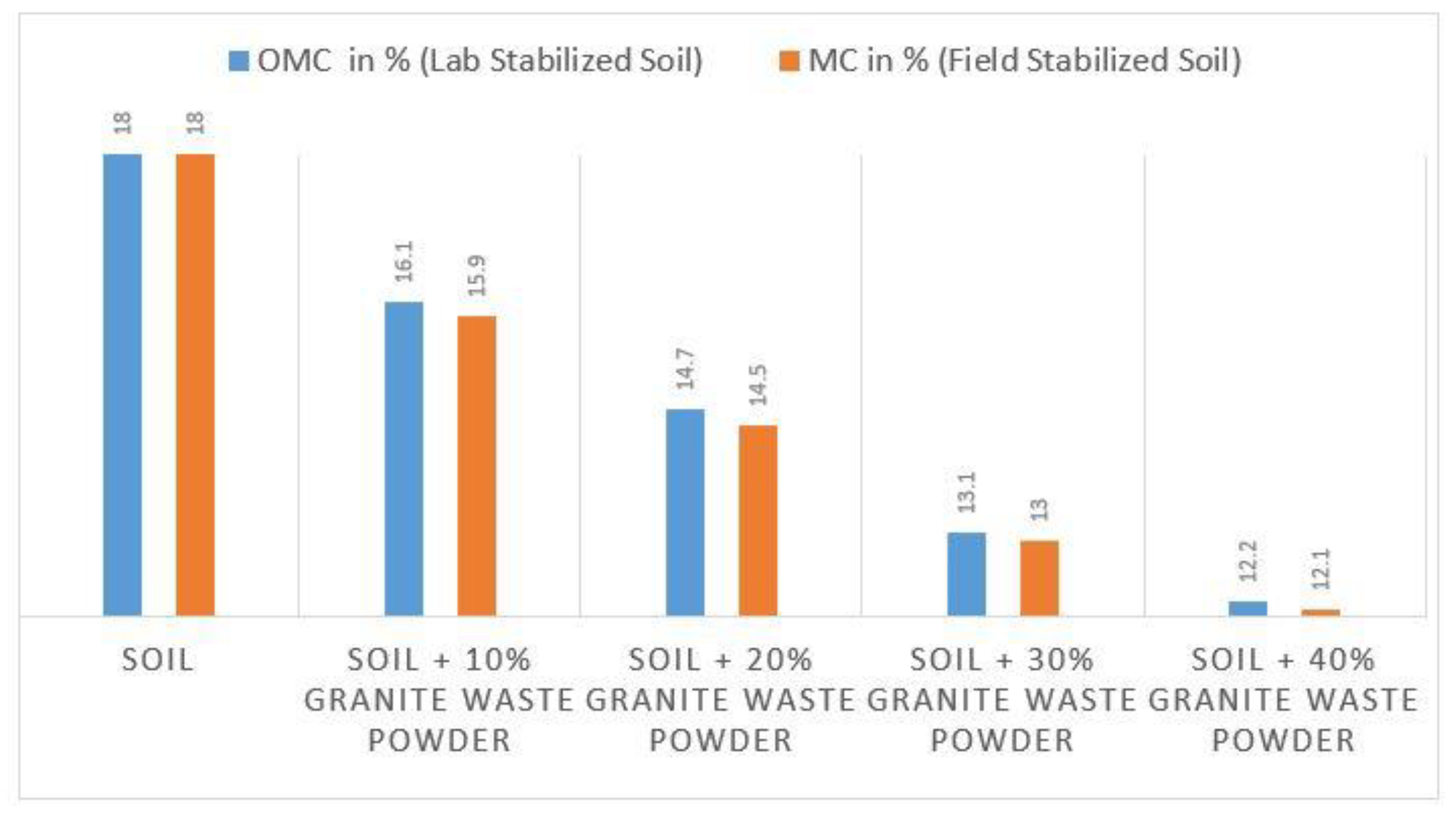

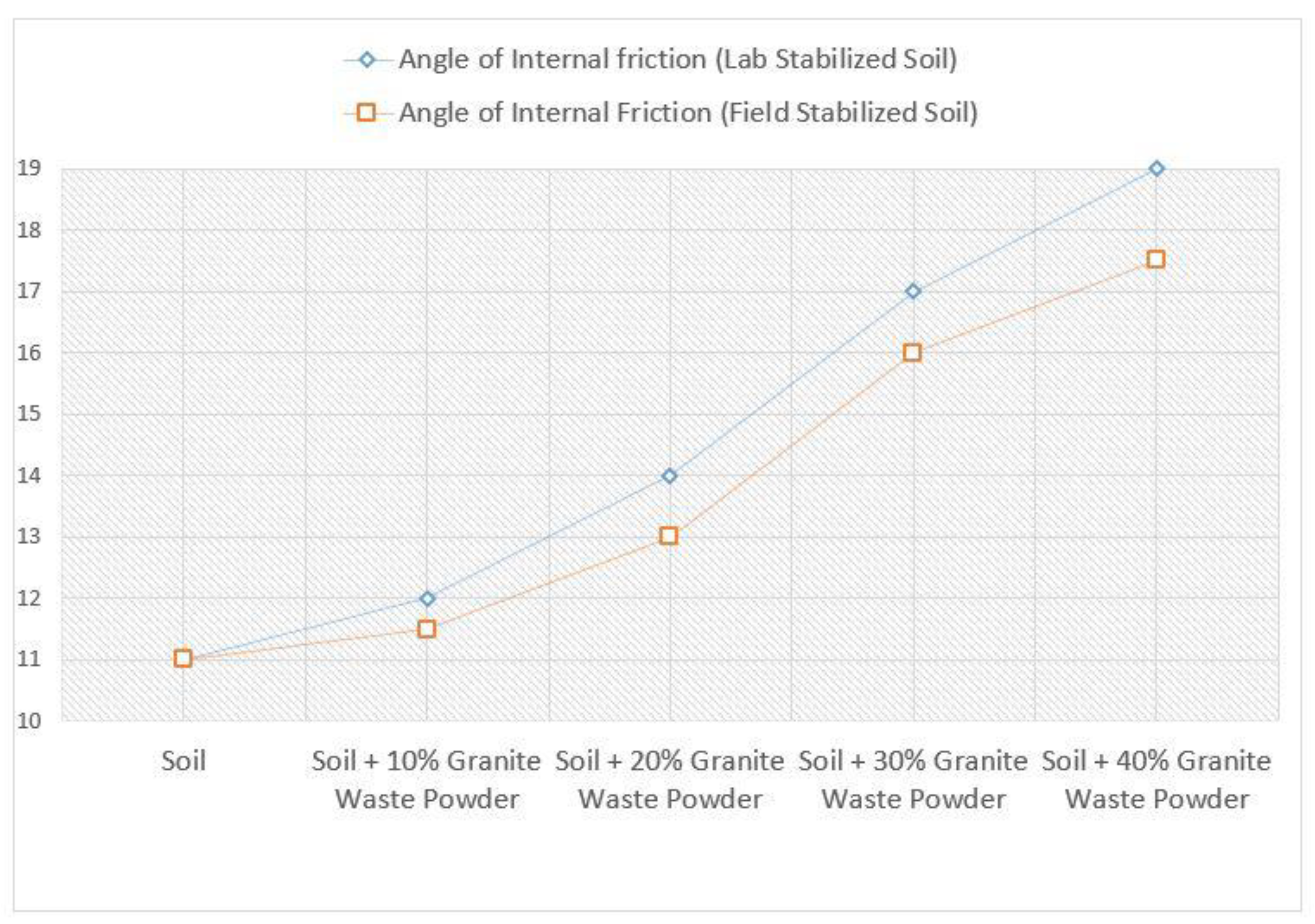
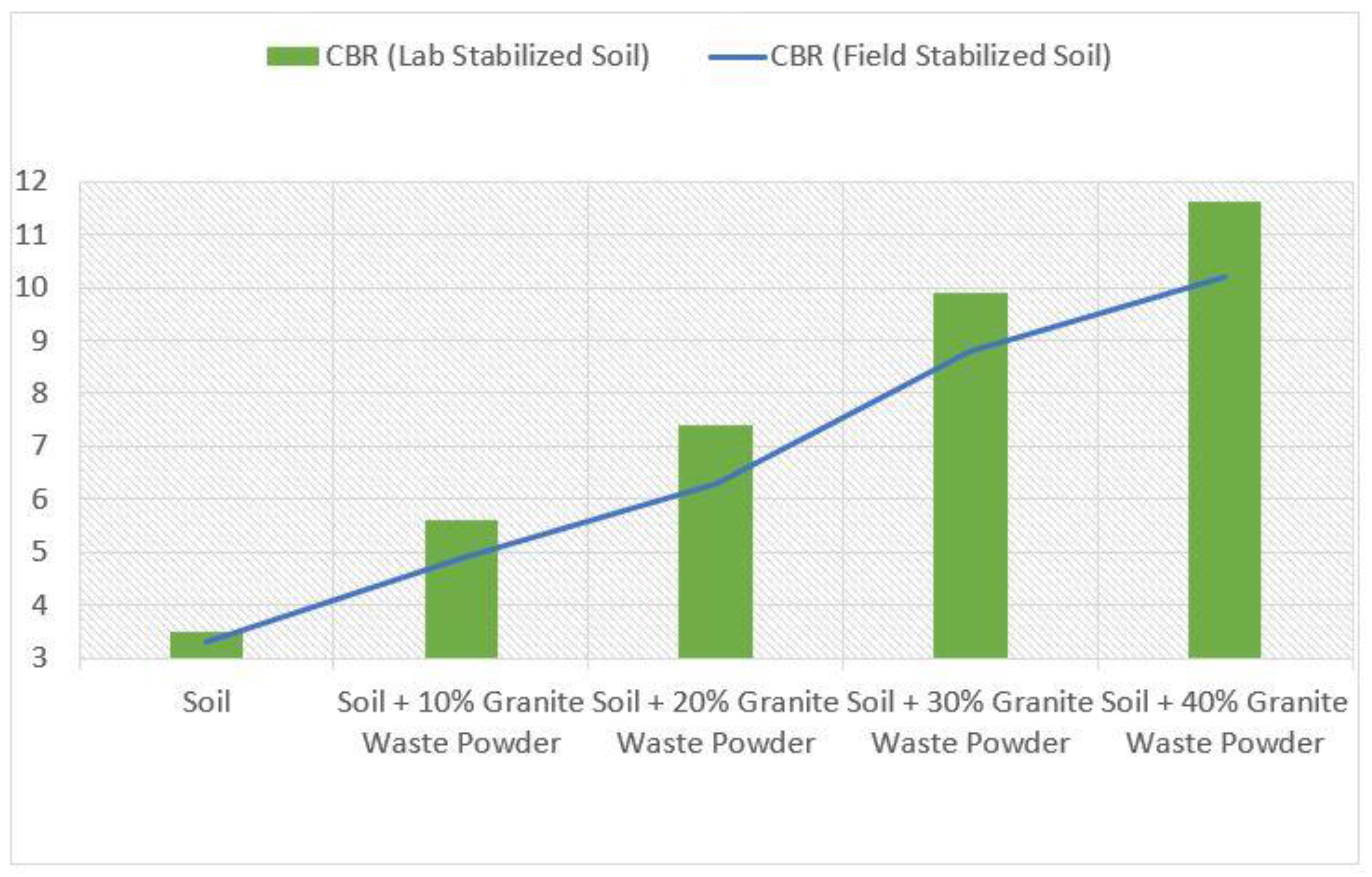

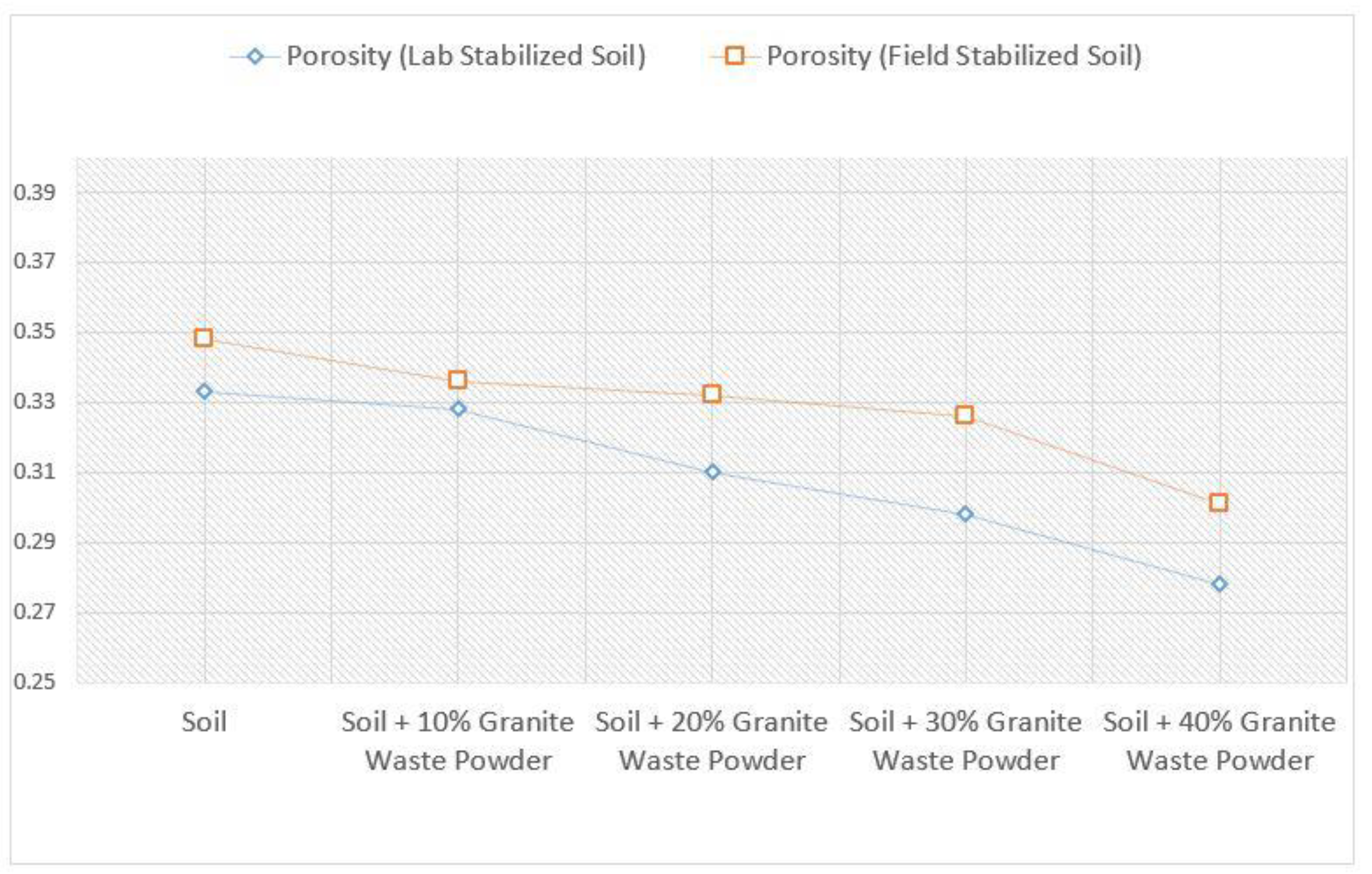
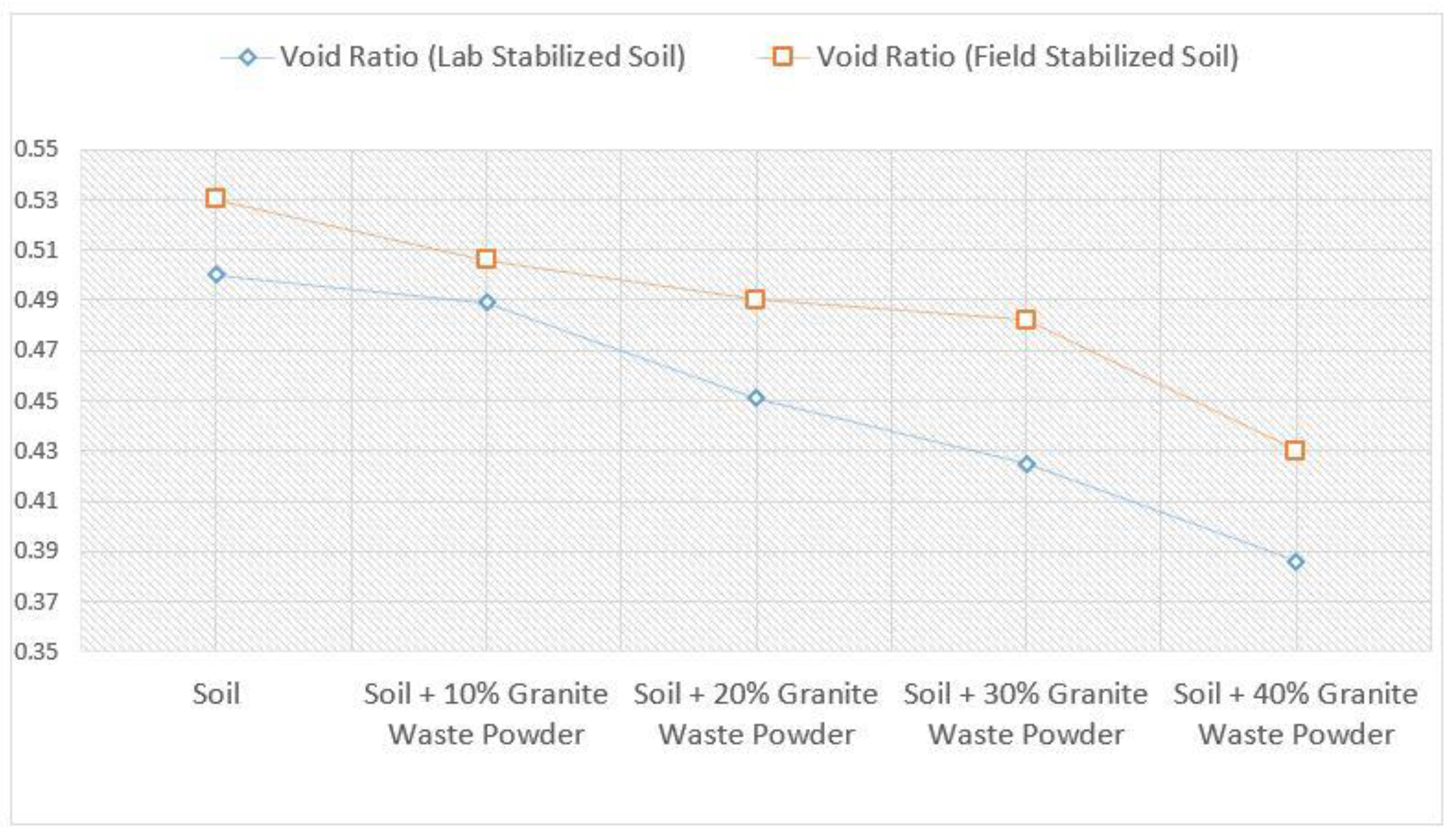
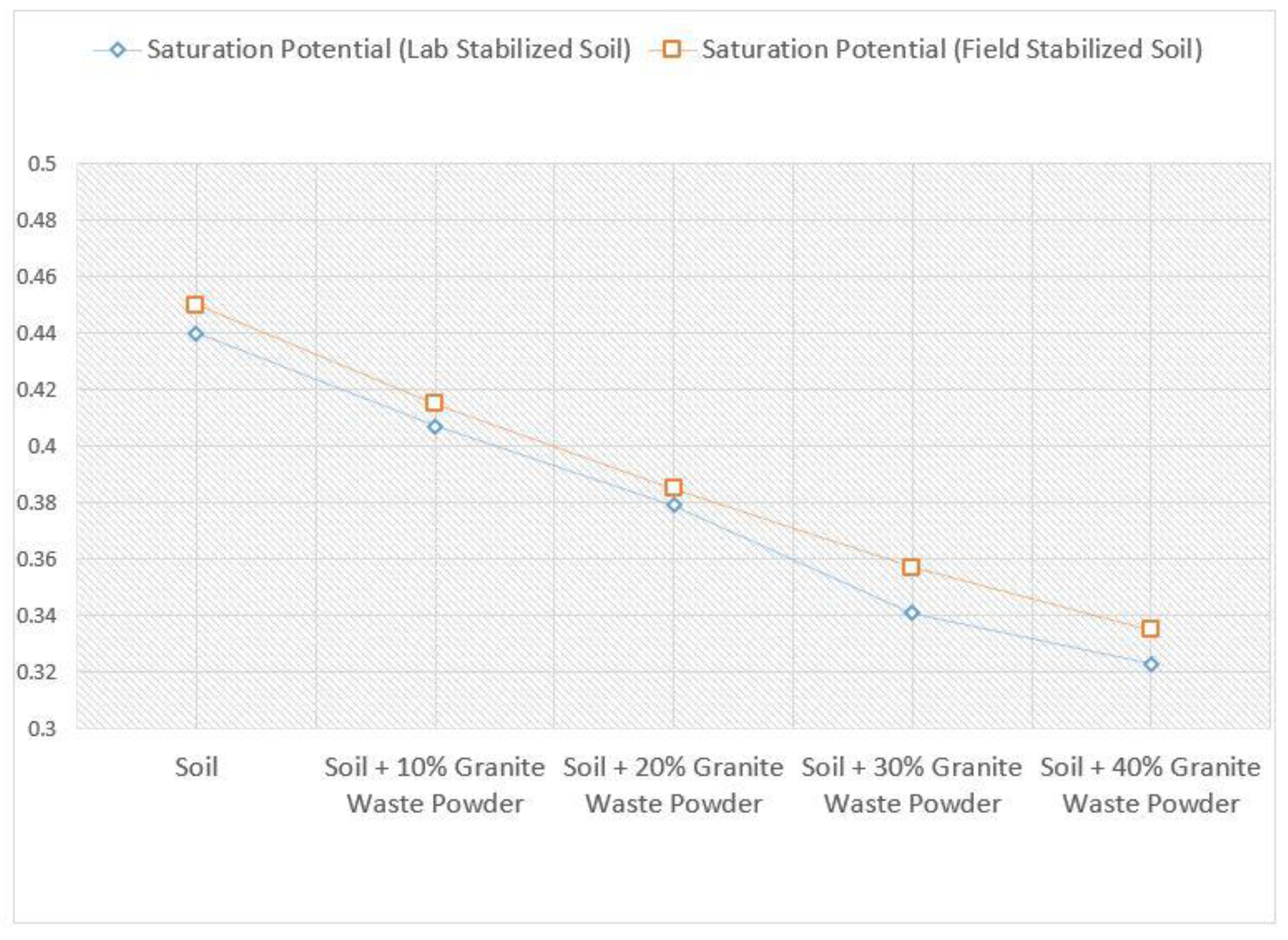
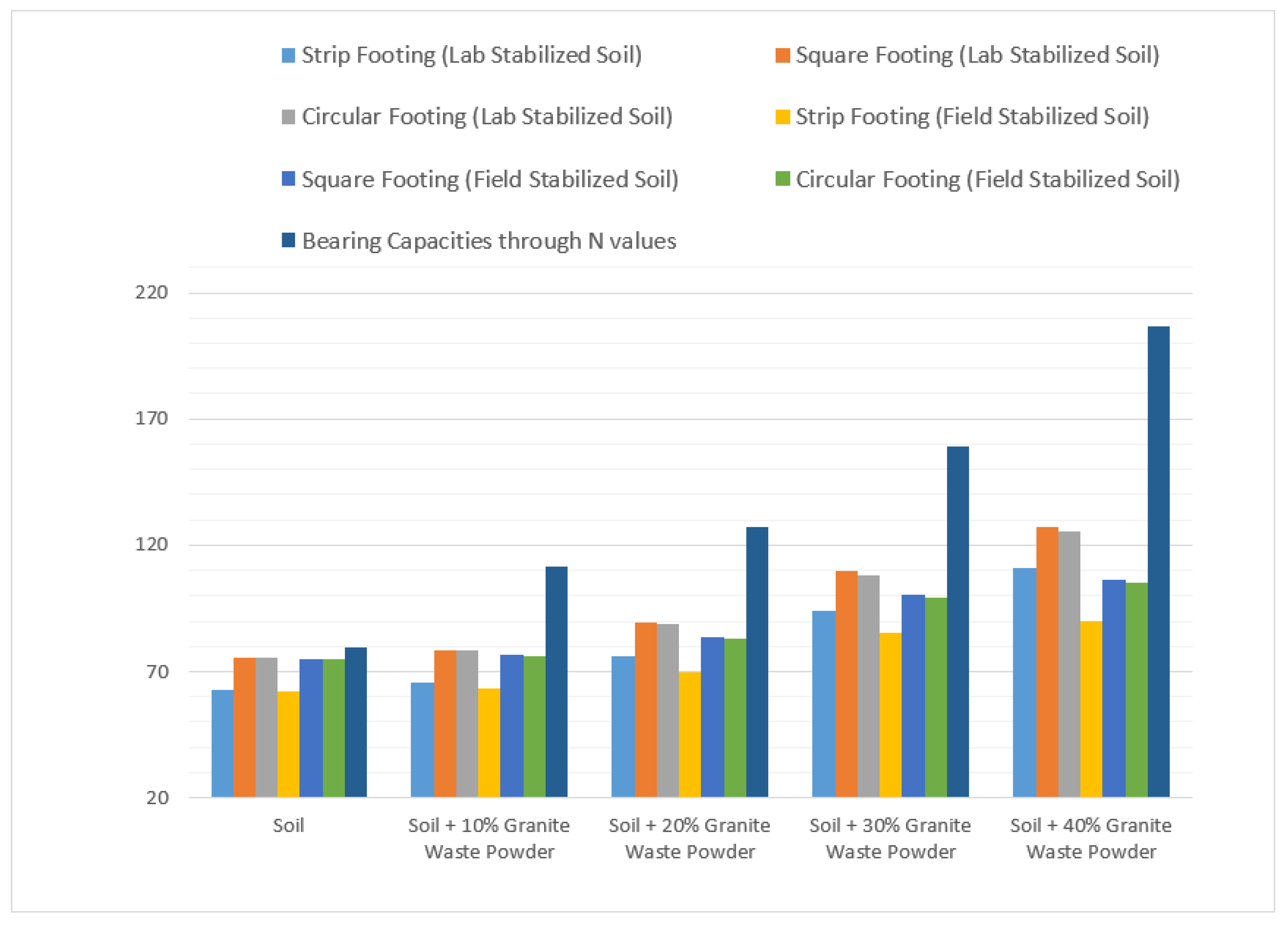
| Sample No. | Description | Weight of Wet Soil (Grams) | Weight of Dry Soil (Grams) | Maximum Dry Density (kN/m3) | Optimum Moisture Content (%) | Specific Gravity | Volume of Mould (cm3) |
|---|---|---|---|---|---|---|---|
| 1 | Soil | 1767 | 1498 | 16.09 | 18 | 2.49 | 911.83 |
| 2 | Soil + 10% Granite Waste Powder | 1776 | 1530 | 16.44 | 16.1 | 2.53 | 911.83 |
| 3 | Soil + 20% Granite Waste Powder | 1840 | 1605 | 17.24 | 14.7 | 2.58 | 911.83 |
| 4 | Soil + 30% Granite Waste Powder | 1866 | 1650 | 17.73 | 13.1 | 2.61 | 911.83 |
| 5 | Soil + 40% Granite Waste Powder | 1935 | 1725 | 18.53 | 12.2 | 2.65 | 911.83 |
| Sample No. | Description | Weight of Wet Soil (Grams) | Weight of Dry Soil (Grams) | Dry Density (kN/m3) | Moisture Content (%) | Specific Gravity | Volume of Core cutter (cm3) |
|---|---|---|---|---|---|---|---|
| 1 | Soil | 2242 | 1900 | 15.80 | 18 | 2.50 | 1178.25 |
| 2 | Soil + 10% Granite Waste Powder | 2271 | 1950 | 16.22 | 16.5 | 2.52 | 1178.25 |
| 3 | Soil + 20% Granite Waste Powder | 2285 | 1985 | 16.51 | 15.1 | 2.55 | 1178.25 |
| 4 | Soil + 30% Granite Waste Powder | 2309 | 2027 | 16.86 | 13.9 | 2.57 | 1178.25 |
| 5 | Soil + 40% Granite Waste Powder | 2383 | 2110 | 17.55 | 12.95 | 2.59 | 1178.25 |
Publisher’s Note: MDPI stays neutral with regard to jurisdictional claims in published maps and institutional affiliations. |
© 2022 by the authors. Licensee MDPI, Basel, Switzerland. This article is an open access article distributed under the terms and conditions of the Creative Commons Attribution (CC BY) license (https://creativecommons.org/licenses/by/4.0/).
Share and Cite
Shah, S.H.A.; Habib, U.; Mohamed, A.; Aziz, M.; Rehman, Q.u.; Saleem, A. Laboratory and In Situ Stabilization of Compacted Clay through Granite Waste Powder. Sustainability 2022, 14, 14459. https://doi.org/10.3390/su142114459
Shah SHA, Habib U, Mohamed A, Aziz M, Rehman Qu, Saleem A. Laboratory and In Situ Stabilization of Compacted Clay through Granite Waste Powder. Sustainability. 2022; 14(21):14459. https://doi.org/10.3390/su142114459
Chicago/Turabian StyleShah, Syed Husnain Ali, Umer Habib, Abdullah Mohamed, Mubashir Aziz, Qasim ur Rehman, and Asma Saleem. 2022. "Laboratory and In Situ Stabilization of Compacted Clay through Granite Waste Powder" Sustainability 14, no. 21: 14459. https://doi.org/10.3390/su142114459
APA StyleShah, S. H. A., Habib, U., Mohamed, A., Aziz, M., Rehman, Q. u., & Saleem, A. (2022). Laboratory and In Situ Stabilization of Compacted Clay through Granite Waste Powder. Sustainability, 14(21), 14459. https://doi.org/10.3390/su142114459









